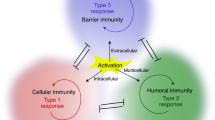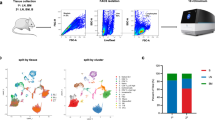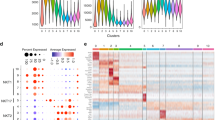Abstract
The H–2 complex has traditionally been interpreted as a maze of regions, subregions and loci coding for different traits. The two main theses presented here are, first, that a single H–2 locus is pleiomorphic in that it controls several functions such as allograft rejection, cell-mediated lymphocytotoxicity, mixed lymphocyte reaction, immune response, immune suppression and restriction of T-cell specificity; and second, that the physiological f unction of the H–2 complex is to guide T lymphocytes in theirfunction of distinguishing self from non-self, and that all other H–2-controlled traits are artificial derivatives of this basic function. These two theses lead to a new, simplified interpretation of the H–2 complex.
This is a preview of subscription content, access via your institution
Access options
Subscribe to this journal
Receive 51 print issues and online access
$199.00 per year
only $3.90 per issue
Buy this article
- Purchase on SpringerLink
- Instant access to full article PDF
Prices may be subject to local taxes which are calculated during checkout
Similar content being viewed by others
References
Klein, J. Biology of the Mouse Histocompatibility-2 Complex (Springer-Verlag, New York, 1975).
Klein, J. Science 203, 516–521 (1979).
Huang, C. -M. & Klein, J. Immunogenetics 11, 605–616 (1980).
Ferreira, A., David, C. S. & Nussenzweig, V. J. exp. Med. 151, 1424–1435 (1980).
Klein, J. Springer Semin. Immunopath. l, 31–49 (1978).
Nabholz, M. & Miggiano, V. C. in B and T Cells in Immune Recognition (eds Loor, F. & Roelants, G. R.) 261–289 (Wiley, Chichester, 1977).
Klein, J. et al. Cell. Immun. 4, 442–446 (1972).
Okuda, K., David, C. S. & Shreffler, D. C. J. exp. Med. 146, 1561–1573 (1977).
Lonai, P. & McDevitt, H. O. Immunogenetics 4, 33–35 (1977).
Benacerraf, B. & McDevitt, H. O. Science 175, 273–279 (1972).
McDevitt, H. O. et al. J. exp. Med. 135, 1259–1278 (1972).
Zaleski, M. & Klein, J. J. exp. Med. 145, 1602–1606 (1977).
Maron, R. & Cohen, I. R. Nature 279, 715–716 (1979).
McDevitt, H. O. J. Immun. 100, 485–492 (1968).
Kapp, J. A. et al. J. exp. Med. 140, 648–659 (1974).
Murphy, D. B. et al. J. exp. Med. 144, 699–712 (1976).
Katz, D. H. et al. Proc. natn. Acad. Sci. U.S.A. 70, 2624–2628 (1973).
Katz, D. H., Hamaoka, T. & Benacerraf, B. J. exp. Med. 137, 1405–1408 (1973).
Heber-Katz, E. & Wilson, D. B. J. exp. Med. 142, 928–935 (1975).
Zinkernagel, R. M. & Doherty, P. C. Nature 248, 701–702 (1974).
Sprent, J. J. exp. Med. 147, 1159–1174 (1978).
Shreffler, D. C. Immun. Rev. 32, 140–167 (1976).
Nathenson, S. G. et al. in Birth Defects, Vol. 14, No. 2 (eds Lerner, R. A. & Bergsma, D.) 566–579 (Liss, New York, 1978).
Michaelson, J. Immunogenetics 13, 167–171 (1981).
Uhr, J. W. et al. Science 206, 292–297 (1979).
Jones, P. P., Murphy, D. B. & McDevitt, H. O. J. exp. Med. 148, 925–939 (1978).
Ferreira, A., Nussenzweig, V. & Oigli, I. J. exp. Med. 148, 1186–1197 (1978).
Klein, J. Adv. Immun. 26, 56–146 (1978).
Nairn, R., Yamaga, K. & Nathenson, S. G. A. Rev. Genet. 14, 241–277 (1980).
Juretić, A., Nagy, Z. A. & Klein, J. Nature 289, 308–310 (1981).
Juretić, A., Nagy, Z. A. & Klein, J. Immunogenetics (submitted).
Klein, J. et al. J. exp. Med. 143, 1439–1452 (1976).
Klein, J., Chiang, C. L. & Wakeland, E. K. Immunogenetics 5, 445–451 (1977).
McKenzie, I. F. C. et al. J. exp. Med. 150, 1323–1328 (1979).
Meo, T. et al. Transplant Proc. 7, 127–129 (1975).
Hämmerling, G. Transplant Rev. 30, 64–82 (1976).
Lozner, E. C. et al. Science 183, 757–759 (1974).
Fathman, C. G., Watanabe, T. & Augustin, A. J. Immun. 121, 259–264 (1978).
Alkan, S. S. Eur. J. Immun. 8, 112–118 (1978).
Schwartz, R. H. & Paul, W. E. J. exp. Med. 143, 529–540 (1976).
Baxevanis, C. N. et al. Immunogenetics 11, 617–628 (1980).
Merryman, C. F. & Maurer, P. H. J. Immun. 116, 739–742 (1976).
Shevach, E. M., Paul, W. E. & Green, I. J. exp. Med. 136, 1207–1221 (1972).
Schwartz, R. H. et al. J. Immun. 117, 531–540 (1976).
Schwartz, R. H. et al. Proc. natn. Acad. Sci. U.S.A. 75, 2387–2391 (1978).
Merryman, C. F. & Maurer, P. H. Immunogenetics 1, 549–559 (1975).
Dorf, M. E. Springer Semin. Immunopath. l, 171–206 (1978).
Lieberman, R. et al. J. exp. Med. 136, 1231–1240 (1972).
Melchers, I., Rajewsky, K. & Shreffler, D. C. Eur. J. Immun. 3, 754–761 (1973).
Baxevanis, C. N., Nagy, Z. A. & Klein, J. Proc. natn. Acad. Sci. U.S.A. (in the press).
Murphy, D. B. Springer Semin. Immunopath. l, 111–131 (1978).
Cantor, H. & Boyse, E. J. exp. Med. 141, 1376–1389 (1975).
Shreffler, D. C. & David, C. S. Adv. Immun. 20, 125–195 (1975).
Cullen, E. S. et al. Immunogenetics 11, 535–547 (1980).
Rich, S. S., David, C. S. & Rich, R. T. J. exp. Med. 149, 114–126 (1979).
Klein, J. et al. Immunogenetics 6, 489–512 (1978).
Zinkernagel, R. M. & Doherty, P. C. Nature 251, 547–548 (1974).
Flaherty, L. in Origins of Inbred Strains (ed. Morse, H. C.) 409–422 (Academic, New York, 1978).
Author information
Authors and Affiliations
Rights and permissions
About this article
Cite this article
Klein, J., JuretiĆ, A., Baxevanis, C. et al. The traditional and a new version of the mouse H–2 complex. Nature 291, 455–460 (1981). https://doi.org/10.1038/291455a0
Issue date:
DOI: https://doi.org/10.1038/291455a0
This article is cited by
-
Generating Hypoimmunogenic Human Embryonic Stem Cells by the Disruption of Beta 2-Microglobulin
Stem Cell Reviews and Reports (2013)
-
Brain β2-microglobulin levels are elevated in the striatum in Parkinson's diseaselevels are elevated in the striatum in Parkinson's disease
Journal of Neural Transmission - Parkinson's Disease and Dementia Section (1995)
-
Preimplantation mouse embryos express Mhc class I genes before the first cleavage division
Immunogenetics (1993)
-
High risk of squamous cell carcinoma of the cervix for women with HLA-DQw3
Nature (1991)
-
β2-Microglobulin deficient mice lack CD4−8+ cytolytic T cells
Nature (1990)



